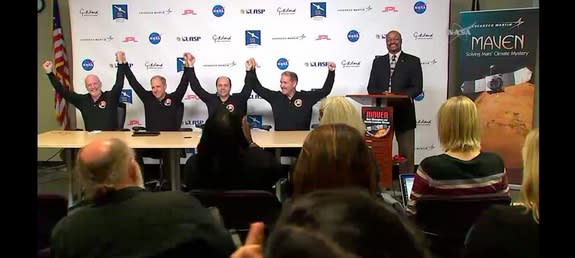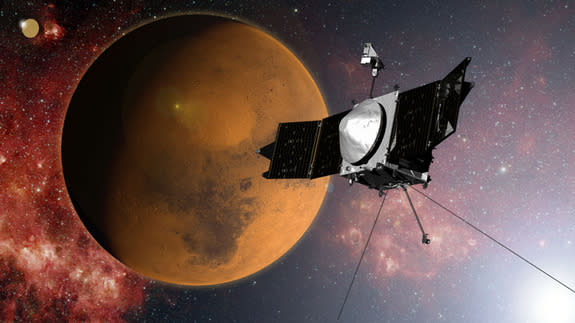NASA Hails Mars Probe's 'Flawless' Arrival at Red Planet
NASA's newest Mars spacecraft is safely in orbit around the Red Planet, and the probe's handlers couldn't be happier.
The MAVEN spacecraft arrived at Mars late Sunday (Sept. 21) after a picture-perfect orbital insertion burn that slowed the probe down enough to be captured by the Red Planet's gravity in a feat that had mission team members cheering with excitement and relief.
"Wow! What a night," MAVEN project manager David Mitchell, of NASA's Goddard Space Flight Center in Greenbelt, Maryland, said Sunday during a press briefing after the probe reached the Red Planet. "You get one shot with Mars orbit insertion, and MAVEN nailed it tonight." [See images from the MAVEN mission]
Preliminary analyses indicate that the spacecraft's orbital insertion burn lasted for 34 minutes and 26 seconds — just 11 seconds longer than planned, Mitchell added.
"It was on right on the money," he said. "So, really happy about that."
MAVEN principal investigator Bruce Jakosky agreed with Mitchell's assessment, describing the probe's performance Sunday night as "absolutely flawless" — which came as a great relief to his jangled nerves.
"I think my heart's about ready to start again," joked Jakosky, who is based at the Laboratory for Atmospheric and Space Physics at the University of Colorado, Boulder.
Meanwhile, at NASA's Goddard Space Flight Center in Greenbelt, Maryland — which is overseeing the MAVEN mission — about 150 mission scientists, NASA officials and other guests, including NASA chief Charles Bolden, watched a live video feed from Jakosky's team as the orbiter arrived at Mars.
"It's just euphoria," Jim Green, NASA's director of planetary science, told SPACE.com at the Goddard center, where the crowd shared a celebratory cake and posed for group photos.
The $671 million MAVEN mission (the name is short for Mars Atmosphere and Volatile Evolution) will investigate how and why the Red Planet lost much of its atmosphere, which once was relatively thick but is now just 1 percent as dense as that of Earth at sea level.
The MAVEN spacecraft will use three instrument suites to study the upper atmosphere of Mars, measuring and characterizing gas escape into space. The mission's observations should help researchers better understand the planet's shift from relatively warm and wet in the ancient past to cold and dry today, team members have said.
MAVEN should begin its science mission in about six weeks, after several more engine burns take it down to its 4.5-hour science orbit and the team has had a chance to check out all the instruments. But the probe's handlers will pause commissioning activities in mid-October to observe the Mars flyby of Comet Siding Spring, which will come within 83,000 miles (132,000 kilometers) of the planet on Oct. 19.
If all goes according to plan, MAVEN will soon be joined by another robot in Mars orbit. India's Mars Orbiter Mission (MOM) probe, the country's first-ever Red Planet effort, is slated to arrive on Tuesday night.
"We're hoping for their success," Jakosky said. "We're sending them the best wishes from the entire MAVEN team for a successful orbit insertion and mission."
Space.com managing editor Tariq Malik (@tariqjmalik) contributed to this story from Greenbelt, Maryland. Follow Mike Wall on Twitter @michaeldwall and Google+. Follow us @Spacedotcom, Facebook or Google+. Originally published on Space.com.
Copyright 2014 SPACE.com, a TechMediaNetwork company. All rights reserved. This material may not be published, broadcast, rewritten or redistributed.


